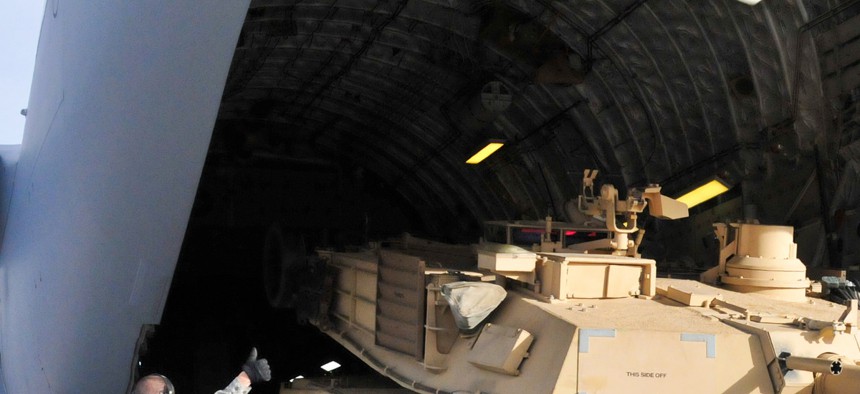
Soldiers from the 4th Infantry Division offload an M1A2 Abrams battle tank from a plane at Fort Carson, on January 13, 2014. U.S. Army photo by Staff Sgt. Grady Jones, 3rd ABCT Public Affairs, 4th Inf. Div.
The Tank That Won't Go Away and Other Details in the New Defense Budget
Key reforms across every section of the Pentagon's budget have been altered or slashed by lawmakers. Here are a few of them. By Janine Davidson
After a process that could generously be described as touch-and-go, President Obama signed a $1.1 trillion dollar omnibus and continuing resolution spending package—the “cromnibus”—on Tuesday evening. It obligates $554 billion dollars for defense spending, which includes $490 billion for the base Pentagon budget and another $64 billion to the Overseas Contingency Fund (OCO). As Military Times reports, this marks an $18 billion dollar decrease from FY14—although the entirety of that reduction comes from a reduced OCO concurrent with the drawdown in Afghanistan. This top-line figure lines up almost exactly with President Obama’s original March request.
However, Congress has made considerable changes to the way this money is spent. According to analysis by Defense News, 10 percent of the FY15 defense appropriations budget—and 30 percent of all line items—were changed in the logrolling process. Likewise, significant proposed reforms across every section of the DoD budget have been altered or slashed. The list of changes is considerable (you can read a Senate Armed Services Committee summary here or even review the full bill here). Some of the most important changes you should be aware of:
All services encounter challenges retiring their platforms—but none more than the Air Force. Congress has forbidden retirement plans for the original MQ-1 Predator; the 50-year-old U-2 spy plane; and the E-3 Airborne Warning and Control System (AWACS) aircraft. It comes down hardest on plans to mothball the A-10 Warthog (which I’ve written about before in great detail). It authorizes the transfer of 36 A-10s from “primary” to “back-up” aircraft inventory, which comes with reduced flying hours; which means savings will be minimal.
Congress also funds other stuff that no one asked for. The biggest ticket items include $120 million more for M-1 Abrams tanks, despite Army protestations (for at least the third straight year) that no additional units are needed. Little surprise—according to General Dynamics, there are more than 560 Abrams subcontractors spread across the country. Likewise, the U.S. Navy was given $850 million to refuel and overhaul the aircraft carrier USS George Washington, despite its intent to wait until the FY16 budget cycle
A small step toward compensation reform. The final agreement limits military pay increases to 1 percent; freezes the pay of general and flag officers; reduces the Basic Allowance for Housing (BAH) by 1 percent relative to average out-of-pocket costs for housing (from 100 percent to 99 percent); authorizes a $3 dollar increase in pharmacy copays for non-active duty TRICARE beneficiaries; and tightens down the availability of non-generic prescription medications. As CFR’s Jesse Sloman writes, this represents a small step toward the compensation reform military leaders have been asking for.
U.S. counterterrorism fund gets gutted. The $4 billion Counterterrorism Partnership Fund, announced by President Obama in May, will only be receiving $1.3 billion (although this does not include funds being used to boost the Iraqi army against ISIS). This notably diminishes planned operations to counter Al Qaeda and ISIS’ global influence, especially in Africa.
A National Commission on the Future of the Army? The final 2015 defense authorization includes a provision for the establishment of a National Commission on the Future of the Army—an eight-member commission to assess the force mixture between active and reserve components, as well as anticipate future mission requirements. This commission (strongly opposed by the Army itself) arises from Congressional dissatisfaction with Army end-strength reductions and the resulting balance between the active and reserve components (active duty to 450,000 and the Guard to 335,000 by 2017).
Notably, nearly all of the most important defense questions have been deferred until 2015. As I noted last month, the sequestration limits of the Budget Control Act (BCA) are set to bite hard next year; Pentagon planners cannot indefinitely delay $20 billion in much-needed maintenance and repairs. A proposed cost-saving 2015 Base Realignment and Closing effort (BRAC) died almost out of the gate and is now essentially a non-issue until 2017. The critical issue of a new congressional Authorization for Use of Military Force (AUMF) against ISIS will likely take center stage in the beginning of the new year.
Finally, debates over such as issues as the AUMF, the future of the A-10, the size of the Army, and compensation reform, will likely all take a back seat to the coming debate over funding to the Department of Homeland Security. DHS has only been funded until the spring under a Continuing Resolution—a protest against changes by President Obama to immigration enforcement policy.
Given the growing threats from terrorism, transnational crime, and cyber-attacks, the Department of Homeland Security will remain integral to national defense.Major turbulence in the DHS budget will not come without risk.
This post appears courtesy of CFR.org.




